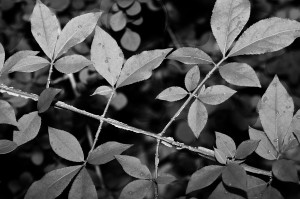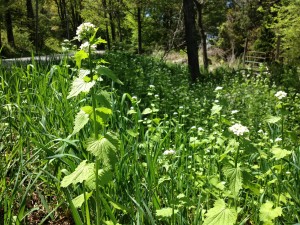ZONE 4
Mounting a Counter Offensive on Invasive Species
By Susannah Wood
Like most of us living in the Icebox of Connecticut, I greet the first signs of spring with a surge of relief and delight at the first sight of the branch tips of the red maples beginning to color, that first phoebe singing outside our bedroom, white bloodroot appearing along the Haystack road, yellow trout lilies and maroon wake robins blooming.
Then, there are the less pleasant harbingers of warm weather as I notice all the invasive species beginning to green up. One often hears someone say with pleasure that Norfolk hasn’t changed in years. Unfortunately, that is not true. Many of the plant communities we see along our roads and in our woods have changed dramatically.
Many roadsides are being taken over by invasive shrubs and herbs. Among the most troublesome in Norfolk are garlic mustard, Japanese barberry, Asiatic bittersweet, Asiatic honeysuckles, euonymus or burning bush, multiflora rose, buckthorn and Japanese knotweed.
Most non-native species are not invasive. Relatively few ever become a serious threat, so what makes for an invasive species? The production of prodigious amounts of seed that remains viable for years in the soil (garlic mustard), the ability to spread both vegetatively and by seed (barberry, knotweed), the exuding of chemicals that change soil chemistry in its favor (Norway maple, garlic mustard) and leafing out earlier in the spring and staying green longer in the autumn, which allows them to photosynthesize longer (this is the case for almost all of the above-named species).
Invasive species can grow in a variety of habitats, spread rapidly, and hop scotch to new locations on car tires, animals, hikers and the wind. As these aggressively successful plants take over, plant diversity declines. That diversity is increasingly important as climate change continues, and that is just a part of the story.
One of the reasons non-native species may be appealing to gardeners is that their foliage is less likely to be on the menu for local insects. Where invasive plants make up a significant percentage of the flora, this creates a problem for breeding birds. When birds arrive in spring and begin to mate, lay eggs and raise their broods, they need a diet high in protein. This diet consists of caterpillars, worms and a variety of flying and crawling insects. Those insects, in turn, rely on native species of plants with which they have evolved over thousands, if not millions, of years. A forest floor covered with barberry and multiflora rose is a grocery store with empty shelves.
One insect those woods will not be lacking is the deer tick. Recent research out of the Connecticut Agricultural Experimental Research Station has revealed that not only do barberry thickets harbor many more ticks than native shrubs, but a much higher percentage of those ticks carry Lyme disease.
Controlling invasive species is not an easy task. Charles Canam of the Center for Ecosystem Studies says that we cannot hope to eradicate these problem plants, but that we may be able to hold them at bay long enough for a community of insects and diseases to discover and tame them.
 So what do we do in the meantime? Experts advise, as soon as you see a colony developing, deal with it. Work in from the perimeter. In a larger infestation, create clear patches to allow native species to regenerate. Where the invasive is spreading into the forest, work from the interior toward the road. If pulling up a plant, try to disturb the ground as little as possible, tamping down the earth as you go. Each invasive has a management regime suited to its pattern of growth. Research exactly what is best for the specific problem you have.
So what do we do in the meantime? Experts advise, as soon as you see a colony developing, deal with it. Work in from the perimeter. In a larger infestation, create clear patches to allow native species to regenerate. Where the invasive is spreading into the forest, work from the interior toward the road. If pulling up a plant, try to disturb the ground as little as possible, tamping down the earth as you go. Each invasive has a management regime suited to its pattern of growth. Research exactly what is best for the specific problem you have.
We can also band together as a community to work on the problem. One idea is for neighbors to adopt a road and tackle the invasive species as a group effort. We can be on the watch for, and tackle new and developing problems (like yellow iris) before they become widespread. We can choose native plants and non-invasive plants in place of invasive species.
For a list of local professionals that can help with various stages of the removal of invasive species, please click on the link for this article on Norfolk Now’s web site, www.nornow.org., or contact Susannah Wood at 860-542-5495.
Mechanical removal/mowing:
Phil Lovett 860-542-0195
Red Raymond 860-542-6969
Sean Muzzulin 860-485-5640
Removal and follow-up control by herbicide and/or drip torch
Marc A. Tonan 860-542-5864
Removal/native plant nursery/organic controls
Nash Pradhan (Ginger Creek Nursery) 860-542-5143
General forestry management including invasive control
David Beers (Connwood Foresters, Inc.) 860-542-3967
Starling Childs/Anthony Irving (EECOS) 860-542-3967
Andrew Bossey 860-379-2686
N.B. If anyone providing one or more of these services locally is not on the list, please contact Norfolk Now.
Additional sources of information on the control of various invasives:
Norfolk Conservation Commission: conservationcommission@norfolkct.org
http://www.hort.uconn.edu/cipwg/art_pubs/GUIDE/guideframe.htm
http://www.nature.org/ourinitiatives/regions/northamerica/unitedstates/vermont/volunteer/nature_conservancy_invasives_landowner_guide
http://www.mam.uconn.edu/links.html
Specific article from the CT Conn. Agricultural Experimental Station on control methods for Japanese barberry: http://www.ct.gov/caes/lib/caes/documents/publications/frontiers/frontiers_vol_57_num_2_spring_2010.pdf


